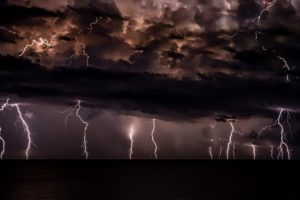 When Mother Nature hits, your home is often in the path of destruction. Storm damage, however minor, can cause expensive long-term problems when repairs aren’t carried out quickly.
When Mother Nature hits, your home is often in the path of destruction. Storm damage, however minor, can cause expensive long-term problems when repairs aren’t carried out quickly.
High winds, heavy rain, flooding, and even lightning can all cause damage to your property. From water running down roof beams into the walls to debris damaging windows, there are many ways a storm or hurricane can damage your property.
The sooner you assess the damage, the quicker you can assess the need for repairs – and start the insurance claim process, too.
Ten Steps to Check Your Home for Storm Damage
Even if you think your home got away with little to no damage during the storm, it’s important to run through this checklist for problems.
1. Check for Visible Debris on the Roof
Tree branches and other debris, no matter how small, can indicate larger impacts have occurred during the storm.
A dented or damaged roof can cause big problems, even if the impact site is only small. Water may have leaked in during the storm, or unattended damage will cause future water damage problems.
Clear any debris you can, if you can access it safely, and inspect the roof shingles for damage.
2. Look for Missing or Broken Roof Shingles
Scan the roof in as much detail as possible. Are any shingles missing or have they slipped during the storm? A shingle that’s still on the roof but has slipped can still be a cause of water damage.
Cracked shingles, if you can see them, are also a sign of weather damage to your home. It could indicate a larger impact from debris, too, which may have affected other parts of the roof.
3. Inspect Your Chimney Flashing and Gutters
The metal flashing around your chimney may have come loose, been dented, or have lifted during the storm. All of this could mean that there is potential water damage inside your home. Water runs underneath the flashing, down the chimney or roof beams, causing dampness.
Your gutters may also have come loose during the storm. A blocked or loose gutter is a sign that your roof may not have drained properly. Water pools on the roof can weaken the structure and cause water damage issues, so it’s important to assess gutter damage immediately after a storm.
4. Assess Water Stains on Interior and Exterior Walls
Are there any clear damp patches either outside or inside your home? Hard and heavy rain during a storm can cause water damage as water runs into small cracks in the walls.
It can take some time for exterior walls to dry out after a storm, so make sure to check them over a period of several days. This will ensure you don’t miss any new damp patches that are made clearer after the storm has fully passed and the house should be dried out.
5. Check Exterior Walls for Holes or Dents
A classic sign of storm or hurricane damage is a spider-web pattern of cracks that radiate out from a central point. This indicates an impact has occurred on the exterior wall that’s serious enough to have affected your cavity foam insulation.
Smaller signs of damage include chipped paint or plaster, or minor holes in the stucco exterior.
6. Look at Every Window in Detail
Your windows may not be clearly broken by the storm, but give them a second look. Small cracks, glass panes that are loose, or even damaged window frames can all lead to much larger problems. Look for signs of water inside your windows, as this indicates a small leak that could be a big problem. Check also for damage caused by flying debris or high winds to your window frames. Dented or cracked frames can cause your window to become loose and a hazard.
7. Scan Your Soffits and Fascias
When you can safely access your soffits and fascias, look closely at the surface. Any dents, cracks and paint chips caused by hail or debris may be a sign of a bigger problem underneath.
If you see a dent or crack in your wooden or PVC soffits, inspect the area in more detail. Is the soffit loose? Has water been drawn into any areas it shouldn’t? Make a note of the dents and paint chips you can see: the more there are, the greater the chance of costly underlying damage.
8. Investigate Your Outbuildings and Fencing
When you’re checking your property after a storm, don’t forget any outbuildings or fences. Walk around your outbuildings and check for signs of water damage, such as dampness or water pooling, as well as any indicators of impact damage such as cracks in the plaster.
Check all windows and frames, and make sure doors haven’t been loosened or damaged by high winds, too.
Take a walk around your perimeter fencing. Make a note of any damaged or missing panels, or of damaged posts that will need to be replaced to secure your boundary once again.
9. Check Crawl Spaces for Water Pools
Look underneath your house in the crawl spaces wherever possible. Check for pools of water, as this can indicate a more serious drainage problem.
It’s important to rid your home of any water pools or flooding underneath the property as soon as possible. Use a sump pump to remove the water, and assess new drainage possibilities to avoid it happening again in the future. Water pooling in crawl spaces can lead to mold growth, wood rot and potential structural damage.
10. Assess Trees and Pylons on Your Property
Check any pylons on or adjacent to your property for signs of damage caused by high winds. Slack or broken cables, or tilting pylons, are all cause for concern. Call the utility supplier as soon as you notice any problems.
You should also check out the trees on your property for loose branches that pose immediate danger to vehicles or your home. Your trees may have survived the storm, but a loose branch may only need a slight breeze to completely bring it down.
When to Call a Storm Damage Repair Expert
There are many small repairs you can carry out yourself after a storm. One slipped shingle here, a broken window pane there – easy. However, when you can see signs of potentially extensive damage, such as cracks on the wall indicating a problem with your insulation, it’s time to call an expert.
Our experienced team can help you fulfill your storm damage repairs, as well as help to prepare your property against hurricanes and bad weather in the future. If you think your home has suffered at the hands of nature, give us a call today.
